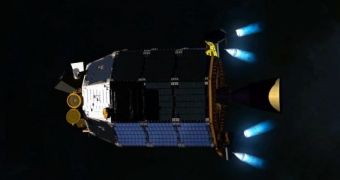Officials at NASA are proud to announce that their Lunar Atmosphere and Dust Environment Explorer (LADEE) orbiter has just completed its primary, 100-day mission around the Moon. The spacecraft will continue its investigations under an extended mission timeline, but researchers are already tallying its impressive discoveries.
The main goal of the mission was to enter orbit around the Moon's equator and then use its onboard instruments to investigate the nature and composition of the lunar exosphere, and also of dust on, above, and around Earth's natural satellite. Its main science tools were therefore a dust detector, a neutral mass spectrometer, and an ultraviolet-visible spectrometer.
LADEE also carries an additional payload, the Lunar Laser Communications Demonstration experiment, which it put through its paces during a 30-day trial run in December 2013. The experiment was so successful that LADEE was able to beam data back to Earth even in broad daylight, or when the Moon was located relatively close to the Sun in the sky. Even more important was the fact that all of these transmissions were not plagued by any errors.
One of the most important objectives that were achieved during the 100-day mission was maintaining the peculiar science orbit LADEE was set in. Perigee values ranged from 20 to 50 kilometers (12.5 to 31 miles), while apogee values varied between 75 and 150 kilometers (47 to 93 miles). In order to maintain this orbit, the spacecraft performed weekly Orbit Maintenance Maneuvers (see video above).
The probe's instruments did not slack either. Its Ultraviolet/Visible Spectrometer (UVS), for example, captured no less than 700,000 spectra of the lunar exosphere. Based on these readings, scientists were able to measure the amount of gas and light that were scattered when they came in contact with dust.
Readings collected by the Neutral Mass Spectrometer (NMS) instrument allowed investigators to follow up on an experiment that began on the Moon during an Apollo mission some 40 years ago. At that time, emissions of the isotope argon-40 were detected on the lunar surface.
Much later, the NASA Lunar Reconnaissance Orbiter (LRO) used its Lyman Alpha Mapping Project (LAMP) far-UV spectrometer to look for argon-40, but found lower-density emissions. One of the things researchers wanted to do with the NMS was determine why argon emissions change with time.
What the instrument found is that argon-40 exhibits diurnal variations, a phenomenon that potentially explains the difference between Apollo and LRO spectrometer readings. In addition to argon, NMS also kept track of neon-20 and helium in the lunar exosphere.
The third scientific payload, the Lunar Dust EXperiment (LDEX), detected around 11,000 dust particle impacts on its detectors since October 2013. These events began as soon as LADEE completed its high-altitude commissioning orbit and turned LDEX on. The main conclusion of this experiment is that lunar dust density increases significantly the closer we get to the surface.
The LADEE mission is led by the Ames Research Center (ARC) in Moffett Field, California and the Goddard Space Flight Center (GSFC) in Greenbelt, Maryland, both at NASA. The spacecraft was launched into space on September 7, 2013, from the Mid-Atlantic Regional Spaceport (MARS), at the NASA Wallops Flight Facility, in Virginia. The probe was delivered to orbit by a Minotaur V rocket.
LADEE entered its selenocentric orbit on October 6, 2013 and reached its planned science orbit on November 20. During its primary, 100-day mission, the spacecraft performed a total of 16 orbit maintenance maneuvers.

 14 DAY TRIAL //
14 DAY TRIAL //